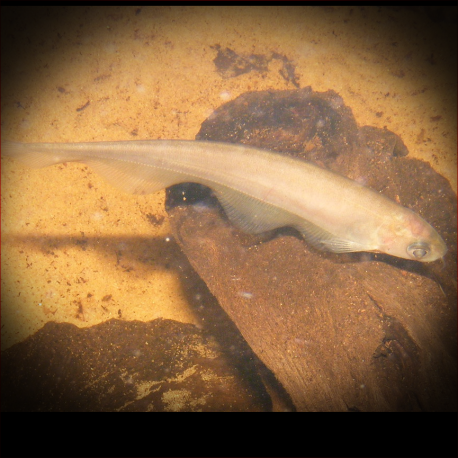More info
Datasheet
| Minimum Tank Size | 200 litres / 52.83 US gallons |
| Maximum Size | 30.0cm / 11.81inches |
| Temperature | 23°C / 73.40°F - 28°C / 82.40°F |
| Hardness | 1-20ºdH |
| pH | 5.8-7.5 |
General Description
Originally classified in the genus Notopterus and reclassified in 1984, Xenomystus Nigri is the only described species of Xenomystus. It possesses unique characteristics, such as a specially adapted swim bladder that acts as an accessory breathing organ, requiring it to periodically rise to the surface to gulp air and emitting a bell-like sound. This scaleless species is notably sensitive to medications, necessitating halved doses of treatments in its tank and avoiding the use of salt. Considered an excellent beginner's knifefish, it is the smallest species kept in aquaria and is quite hardy, displaying interesting behavior and sinusoidal movement.
Aquarium Setup
The ideal aquarium setup for Xenomystus Nigri includes dense planting, dim lighting, and various hiding spots like clay flowerpots, smooth stones, and bogwood caves. Anubias species attached to bogwood are recommended for a biotope tank, thriving in the knifefish's preferred gloomy conditions. Soft sand substrate, along with dried leaves and peat fiber, can further enhance the authenticity and aesthetics of the tank setup.
Behaviour
Xenomystus Nigri can be housed with larger characins, medium-sized peaceful cichlids, butterfly fish, and specific catfish species. While young individuals can be kept in groups, adult knifefish become increasingly territorial, necessitating a relatively large tank to accommodate multiple adults. This species is known for its nocturnal nature, initially shy but gradually becoming bolder with time. Notably, it can swim in a sinusoidal pattern and even backward, compensating for its lack of bright colors.
Feeding and Diet
As a primarily carnivorous species, Xenomystus Nigri readily accepts various meaty live or frozen foods in captivity. A varied diet is recommended, including bloodworms, prawns, mussels, earthworms, and carnivore pellets. Some specimens can adapt to consuming dried foods, ensuring proper nutrition and health maintenance.
Reproduction & Dimorphism
Reproduction of Xenomystus Nigri has been observed in aquarium settings, with courtship involving characteristic barking sounds. The male guards the brood of 150-200 eggs laid on surfaces like wood or rocks and tends to them by fanning with fins. After hatching within approximately 10 days, the male should be removed, and the fry can be fed brine shrimp nauplii or microworms as initial sustenance. Sexual dimorphism in this species involves females appearing plumper when carrying eggs.
Habitat and Distribution
Found in overgrown, still waters, Xenomystus Nigri has a wide natural distribution covering areas in Nigeria, Cameroon, Democratic Republic of Congo, Egypt, and several other regions. This species' adaptability to various conditions, coupled with its ease of maintenance in captivity, suggests its capability to thrive across a diverse range of habitats and ecosystems.

